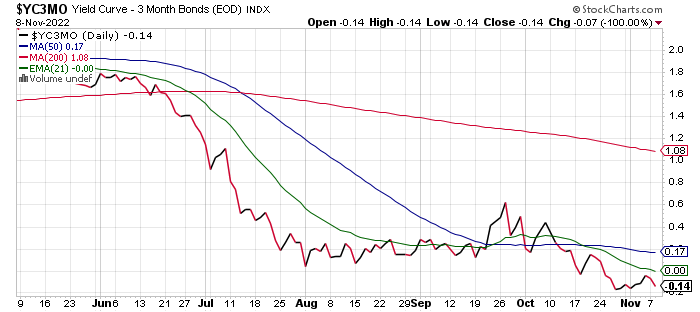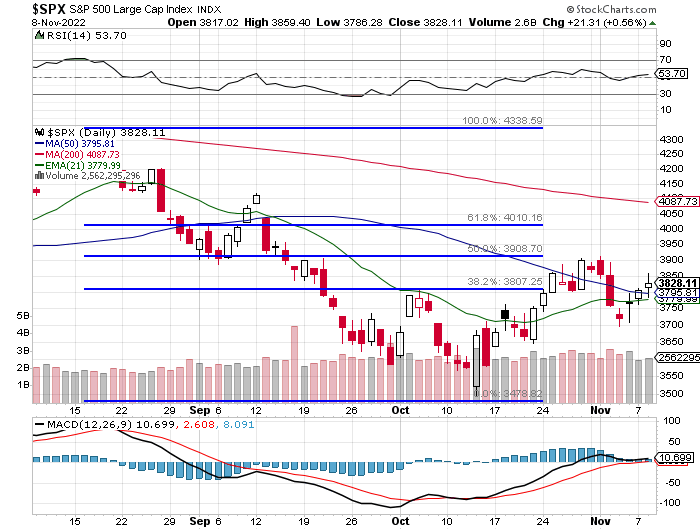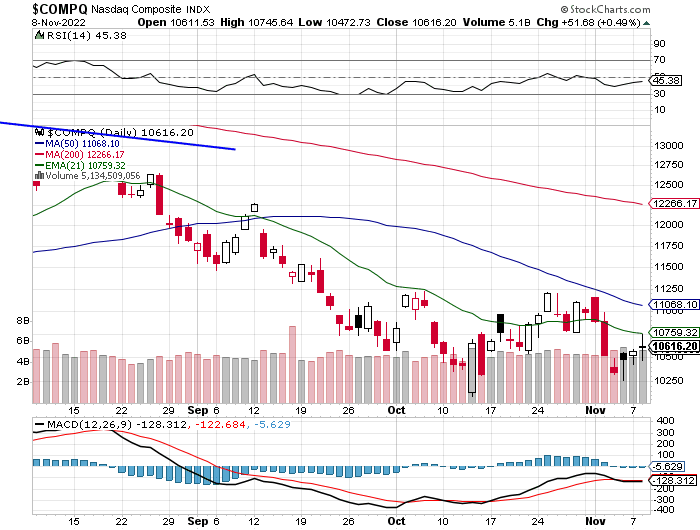Curveball
Zero Dark Thirty. Well, that was a long night.
It started with The Walt Disney Company (DIS). Disney kicked off the evening when it reported a truly awful quarter in terms of corporate execution shortly after the closing bell. Markets had mostly performed well on Tuesday, as they had on the Monday and Friday before that. Why wouldn’t they? Everyone knows that a gridlocked government is good for stocks, the president’s party always does poorly in midterm elections, and that this president has very low approval ratings two years into his first term.
Perhaps we should have considered the fact that this president’s predecessor, a lightning rod to inspire his loyalists and opponents alike, was still out there… endorsing candidates and more than hinting at his own political return. Because there would be no red wave on Tuesday night.
There are enough unfilled seats in both the Senate and the House that the GOP could potentially take control of both chambers. However, that possibility is looking more and more remote as right now, the only Senate seat that flipped turned blue, and the House will be far closer than projected.
Granted, even with a slim majority in the House, it would be a deadlocked government, but there’s no denying that whatever you think of President Joe Biden — and don’t accuse me of being political, because I really try to keep my opinions to myself — Biden has easily outperformed almost every recent to semi-recent president in his first midterm election. Perhaps this is due more to his predecessor’s commitment than his own performance. For whatever reason or cause, what’s on the scoreboard at the end of the game is what matters, and the scoreboard tells a story of GOP disappointment.
Potential market impact
If one believes that the stock rally over the past few days was simply traders (and algorithms) leading an anticipated red wave in anticipation of increased GOP influence in Washington, then one also has to believe that this recent strength will dissipate quickly. On that note, US stock index futures are trading lower very early Wednesday morning. If one believes that this recent stock market strength was simply dependent on any gridlock at all – the reason is that GOP control of even just the House by a small margin would be enough to thwart the Biden agenda and still curb inflation through arrested fiscal grandeur and an inability to produce new regulation — then that game is still on, and may be for a little while.
Marketplace
While U.S. stocks in most measures posted a third day of gains on the bandwagon on Tuesday, trading volume stayed below recent norms for the second day in a row. This rally most likely has a lot to do with a US dollar falling in value versus a basket of its reserve currencies for a third day and Treasury yields falling for the session.

Investors bought most of the Treasury basket ahead of election night and ahead of this afternoon’s upcoming auction of $35 billion in U.S. 10-year notes. However, the yield differential between the 10-year note and the three-month U.S. Treasury note that had improved and moved toward un-inverting moved in the wrong direction on Tuesday, signaling likely economic distress in our future.
It was perhaps a hint of what was to come in Tuesday’s stock market development. Winners beat losers by roughly 3 to 2 on the New York Stock Exchange and by the slimmest of margins on the Nasdaq Market Site as gains in volume took moderate shares of 62.7% and 54.5%, respectively, of composite trading for names listed on those exchanges. I have already mentioned the less than convincing overall trading volume.
On the bright side…

… The S&P 500 found support at its 50-day simple moving average (SMA) on Tuesday. We can learn early how much stickiness this level has. It hasn’t had much ability to hold on to recent moves above that line.
On the not so bright side…

… The Nasdaq Composite was rather rudely rejected on Tuesday at its 21-day exponential moving average (EMA). Recent history suggests that if the Nasdaq Composite can take this line, it could hold for more than a week at the minimum.
Bitcoin
What happened was that FTX was hit with about $6 billion in withdrawals in the three days leading up to Tuesday morning when Sol, which is/was the original symbol of the Solana blockchain which is/had been used by both FTX and Alameda Research, fell dramatically. . This forced Sam Bankman-Fried to contact billionaire and one-time antagonist CZ Zhao of Binance for a rescue. Binance has agreed to buy FTX, but not FTX (US), which is a separate exchange in a “non-binding” agreement. This means that the agreement may nevertheless fall through.
I see Bitcoin trading below $17,500 a piece this morning, down almost 7% after the low of $17,172 on Tuesday, which was down 17% for the day at the time. Almost every other digital token or coin also declined significantly. Can cryptocurrencies, as an asset class, stabilize here at these levels? Everything is possible. I have long felt that this asset class was grossly overvalued, and I still do.
That said, first-month gold futures rose nearly $100 an ounce from last Thursday’s low to Tuesday’s high. I saw a last sell for gold this morning at about $1707.
Under the radar…
Outside of Beijing, that is. A US delegation led by Assistant US Trade Representative Terry McCartin met with Taiwanese counterparts in New York City on Tuesday in meetings intended to improve economic ties and trade relations between the two nations. The meetings covered agriculture and digital technology specifically as Taiwan, thanks to Taiwan Semiconductor (TSM), is the world’s leading foundry and a dominant player in the advanced semiconductor manufacturing space. Taiwan is also a key client state for US defense and aerospace firms and a strategic geopolitical partner as this island nation is not regarded as sovereign by the Chinese mainland authority.
A follow-up meeting is planned later this month when US Trade Representative Katherine Tai plans to travel to Asia for the ministerial meeting on 13-17. November in the Asia-Pacific Economic Cooperation (APEC) organisation. Taiwan is a member and Tai’s Taiwanese counterpart, John Deng, is expected to attend. At the same time, the US and Chinese authorities are believed to be trying to arrange a side meeting between Presidents Joe Biden and Xi Jinping at the G-20 summit in Bali on November 15-16. Wondering how it will go…
Overweight
I’m sure most readers noticed that Amgen’s ( AMGN ) Olpasiran did well in Phase 2 clinical trials and will now move on to Phase 3 testing. After being tested for obesity, patients in the “low dose” group lost an average of 7.2% of their body weight over 85 days. Patients in the “high dose” group lost an average of 14.5% of their body weight. This will put Amgen in direct competition with Novo Nordisk’s ( NVO ) Wegovy and Eli Lilly’s ( LLY ) Mounjaro, which is already approved for the treatment of diabetes but is also in clinical testing as a treatment for obesity. AMGN ran 5.55% to $292.39 on Tuesday.
In Phase 3 testing, patients receiving Wegovy for 68 weeks (not days) lost close to 17% of their body weight. However, Wegovy is still in short supply. When tested at the highest dose for 72 weeks, Mounjaro showed an average loss of 22.5% of one’s body weight. At the 12-week mark (84 days), making the test comparable to that conducted by Amgen, Mounjaro produced an average weight loss of 8% of body weight.
I am long LLY largely for this reason and expect the approval process to potentially go smoothly for Mounjaro since the drug is already approved and in use for a completely different indication.
Mr. Toad’s Wild Ride
Given the time of day and the space already taken up in this column, I have to come back with a piece on Disney’s terrible quarterly earnings. I have received several requests overnight to cover this name this morning for Real Money and Real Money Pro. I won’t leave you in the lurch. After all, I have long been a small to medium-sized position myself. My analysis will be available to you soon.
Economy (All Times Eastern)
06:00 – MBA 30-year mortgage rate (weekly): Last 7.06%.
06:00 – MBA loan applications (weekly): Last -0.5%.
10:00 – Wholesale inventory (Sep-Feb): Flashed 0.8% m/m.
10:30 – Oil inventory (weekly): Last -3.115 million.
10:30 – Petrol warehouse (weekly): Last -1.257 million.
13:00 – Ten-year note auction: 35 billion dollars.
Fed (All Times Eastern)
11:00 – Lecturer: Richmond Fed Pres. Tom Barkin.
Today’s earnings highlights (Consensus EPS expectations)
Before the opening: (DHI) (5.15), (RBLX) (-.36)
After the conclusion: (U) (-.15), (WYNN) (-1.01)


